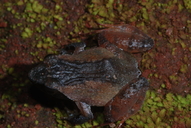|
Phrynobatrachus ruthbeateae Rödel, Doherty-Bone, Kouete, Janzen, Garrett, Browne, Gonwouo, Barej & Sandberger, 2012
Ruth Beate's Puddle Frog | family: Phrynobatrachidae genus: Phrynobatrachus |
| Species Description: Roedel M-O, Doherty-Bone T, Kouete MT, Janzen P, Garrett K, Browne R, Gonwouo NL, Barej MF, Sandberger L 2012 A new small Phrynobatrachus (Amphibia: Anura: Phrynobatrachidae) from southern Cameroon. Zootaxa 3431: 54-68. | |
 © 2012 Dr. Peter Janzen (1 of 5) |
|
|
|
Description Sexual Dimorphism: Female Phrynobatrachus ruthbeateae have thinner fingers than males, with more conspicuous finger discs. Females are also black on the back and upper part of the head; they have a dorsal pattern with beige flanks whereas males have a uniformly light brown to reddish brown dorsal pattern. Females have extended scapular ridges along the dorsolateral line, a white and smooth throat, uniformly black lower mandibles, and no spines on the throat. Males can be distinguished by their black throats with large black spines anteriorly; they have an almost uniform brown to reddish brown dorsal pattern (Rödel et al. 2012). Diagnosis: Phrynobatrachus ruthbeateae can be distinguished from other members of the Phrynobatrachus subgenus by its small body size (<20.0 mm), white belly, short shanks, lack of nuptial pads in breeding males, presence of black spines and skin folds on male throats, uniformly black mandible in females, developed pedal webbing, convergence of the scapular ridges in a straight line, dorsal ridges, distinct but less developed webbing, black vocal sac in males, and visible tympanum (Rödel et al. 2012). Coloration in life: Phrynobatrachus ruthbeateae is a basic beige brown color on the top of the head, upper flank, and the back and top surfaces of the limbs. The tops of the feet are brown-orange. A black lateral face mask extends from the tip of the snout to the bases of the forearm; a lateroventral black band continues below the arms to the groin region. There is a blurred, dark band in the posterior part of the interorbital space; a more narrow, light band lies between the eyelids, anterior to the blurred, dark band. Phrynobatrachus ruthbeateae has black pupils surrounded by one lighter, red-golden ring, and the irises are golden. The top of the right thigh has five dark cross-bars and the top of the left thigh has four. The right shank has four dark cross-bars and the left has three. The posterior part of the top of both thighs is uniformly dark brown. A broad black triangle surrounds the vent and extends toward the belly. The throat is black and the pectoral region is white with a few small black points. A black ventrolateral band borders the white belly. The undersides of the lower arms are black, while the undersides of the forelimbs are gray. Phrynobatrachus ruthbeateae is yellowish to orange in the groin area and the lower surfaces of the thighs; a black line borders the lower part of the thighs anteriorly and the undersides of the feet are dark brown (Rödel et al. 2012). Coloration in preservation (ethanol after almost two years): The specimen's pattern is subtlety fainter. The scapular ridges are no longer visible and the dorsal skin is smooth (Rödel et al. 2012). Variation: Male Phrynobatrachus ruthbeateae can have a snout-vent length of 17.2-17.8 mm. Rödel et al. 2012 reports a snout-vent length variation of 13.3-19.7 mm in females, but the authors are not sure if this range includes the snout-vent length of juvenile specimens. The irises can be golden, red, or dark gray in color and the top of the skin can vary from granular to slightly warty (Rödel et al. 2012). Distribution and Habitat Country distribution from AmphibiaWeb's database: Cameroon
Life History, Abundance, Activity, and Special Behaviors Comments
References
Rödel, M.-O., Doherty-Bone, T., Kouete, M.T., Janzen, P., Garrett, K., Browne, R., Gonwouo, N.L., Barej, M.F., Sandberger, L. (2012). ''A new small Phrynobatrachus (Amphibia: Anura: Phrynobatrachidae) from southern Cameroon.'' Zootaxa, 3431, 54-68. Originally submitted by: Amanda D. Wong (first posted 2012-09-28) Edited by: Michelle S. Koo (2021-08-22) Species Account Citation: AmphibiaWeb 2021 Phrynobatrachus ruthbeateae: Ruth Beate's Puddle Frog <https://amphibiaweb.org/species/7894> University of California, Berkeley, CA, USA. Accessed May 24, 2025.
Feedback or comments about this page.
Citation: AmphibiaWeb. 2025. <https://amphibiaweb.org> University of California, Berkeley, CA, USA. Accessed 24 May 2025. AmphibiaWeb's policy on data use. |



 Map of Life
Map of Life